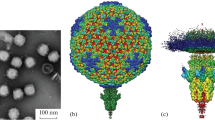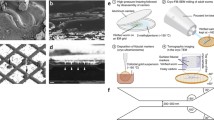Summary
Numerous plasmodesmata occur in the walls between the secretory cells ofTamarix salt glands. The plasmalemma bounds the plasmodesmata and is continuous from cell to cell. In freeze-fracture, the e-face of the plasmalemma within the plasmodesmata is virtually devoid of intramembranous particles while, in contrast, the p-face is decidedly enriched with particles. The axial components appear to be a tightly curved membrane bilayer, as judged from measurements and their appearance in freeze-fracture, and the e-face of this membrane is also devoid of particles. Observations from both thin sections and freeze-fracture replicas indicate the presence of a circular cluster of six particles around the axial component near the cytoplasmic termini of the plasmodesmata. These particles extend from the p-face of the axial component to the p-face of the plasmalemma. These observations are summarized in a model.
Similar content being viewed by others
References
Branton, D., Bullivant, S., Gilula, N. B., Karnovsky, M. J., Moor, H., Muhlethaler, K., Northcote, D. H., Packer, L., Satir, B., Satir, P., Speth, V., Staehelin, L. A., Steere, R. L., Weinstein, R. S., 1975: Freeze-etching nomenclature. Science (N.Y.)190, 54–46.
Browning, A. J., Gunning, B. E. S., 1977: An ultrastructural and cytochemical study of the wall-membrane apparatus of transfer cells using freeze-substitution. Protoplasma93, 7–26.
Evert, R. F., Eschrich, W., Heyser, W., 1977: Distribution and structure of plasmodesmata in mesophyll and bundle-sheath cells ofZea mays L. Planta136, 77–89.
Fisher, D. G., Evert, R. F., 1982: Studies of the leaf ofAmaranthus retroflexus (Amaranthaceae): ultrastructure, plasmodesmatal frequency, and solute concentration in relation to phloem loading. Planta155, 377–387.
Gunning, B. E. S., Overall, R. L., 1983: Plasmodesmata and cell-to-cell transport in plants. Bioscience33, 260–265.
—,Robards, A. W., 1976: Intercellular communication in plants: Studies on plasmodesmata, 387 pp. Berlin-Heidelberg-New York: Springer.
Grant, C. W. M., 1983: Lateral phase separations and the cell membrane. In: Membrane fluidity in biology, Vol. 2 (Aloia, R. C., ed.), pp. 131–150. New York: Academic Press.
Hepler, P. K., 1982: Endoplasmic reticulum in the formation of the cell plate and plasmodesmata. Protoplasma111, 121–133.
Horne, R. W., Markham, R., 1972: Application of optical diffraction and image reconstruction techniques to electron micrographs. In: Practical methods in electron microscopy, Vol. 1, Part 2 (Glauert, A. M., ed.), pp. 327–434. Amsterdam: North Holland.
James, R., Branton, D., 1973: Lipid- and temperature-dependent structural changes inAcholeplasma laidlawii cell membranes. Biochim. biophys. Acta323, 378–390.
Juniper, B. E., Barlow, P. W., 1969: The distribution of plasmodesmata in the root tip of maize. Planta89, 352–360.
Locke, M., Krishnan, N., 1971: Hot alcoholic phosphotungstic acid and uranyl acetate as routine stains for thick and thin sections. J. Cell Biol.50, 550–556.
López-Sáez, J. F., Giménez-Martín, G., Risueño, M. C. J., 1966: Fine structure of the plasmodesm. Protoplasma61, 81–84.
Oleson, P., 1979: The neck constriction in plasmodesmata: evidence for a peripheral sphincter-like structure revealed by fixation with tannic acid. Planta144, 349–358.
Overall, R. L., Wolfe, J., Gunning, B. E. S., 1982: Intercellular communication inAzolla roots. I. Ultrastructure of plasmodesmata. Protoplasma111, 134–150.
Pinto da Silva, P., Branton, D., 1970: Membrane splitting in freeze-fracture etching. Covalently bound ferritin as a membrane marker. J. Cell Biol.45, 598–605.
Platt-Aloia, K. A., Thomson, W. W., 1982: Freeze-fracture of intact plant tissues. Stain Technol.57, 327–334.
Rash, J. E., Hudson, C. S., 1979: Freeze fracture: Methods, artifacts, and interpretations, 204pp. New York: Raven Press.
Reynolds, E. S., 1963: The use of lead citrate at high pH as an electron-opaque stain in electron microscopy. J. Cell Biol.17, 208–212.
Robards, A. W., 1968 a: Desmotubule—a plasmodesmatal sub-structure. Nature218, 784.
—, 1968 b: A new interpretation of plasmodesmatal ultrastructure. Planta82, 200–210.
—, 1976: Plasmodesmata in higher plants. In: Intercellular communication in plants: Studies on plasmodesmata (Gunning, B. E. S., Robards, A. W., eds.), pp. 15–53. Berlin-Heidelberg-New York: Springer.
Spurr, A. R., 1969: A low-viscosity epoxy resin embedding medium for electron microscopy. J. Ultrastruct. Res.26, 31–43.
Thomson, W. W., 1969: Ultrastructural studies on the epicarp of ripening oranges. Proc. First Intern. Citrus Symp. Vol.3, 1163–1169.
—,Liu, L. L., 1967: Ultrastructural features of the salt gland ofTamarix aphylla L. Planta73, 201–220.
Tucker, E. B., 1982: Translocation in the staminal hairs ofSetcreasea purpurea. I. A study of cell ultrastructure and cell-to-cell passage of molecular probes. Protoplasma113, 193–201.
Willison, J. H. M., 1976: Plasmodesmata: a freeze-fracture view. Can. J. Bot.54, 2842–2847.
Zee, S.-Y., 1969: The fine structure of differentiating sieve elements ofVicia faba. Aust. J. Bot.17, 441–456.
Author information
Authors and Affiliations
Rights and permissions
About this article
Cite this article
Thomson, W.W., Platt-Aloia, K. The ultrastructure of the plasmodesmata of the salt glands ofTamarix as revealed by transmission and freeze-fracture electron microscopy. Protoplasma 125, 13–23 (1985). https://doi.org/10.1007/BF01297346
Received:
Accepted:
Issue Date:
DOI: https://doi.org/10.1007/BF01297346




